Microsoft BUILD: Windows 8, A Pre-Beta Preview
by Brian Klug & Ryan Smith on September 13, 2011 12:05 PM EST- Posted in
- BUILD
- Windows
- Microsoft
- Windows 8
- Trade Shows
The Metro UI
The best way to describe Windows 8 is a cross between the Metro UI from Window Phone 7 and the desktop architecture of Windows 7. In fact, virtually everything but the desktop gets a Metro treatment in Windows 8.
The Windows home screen starts initially hidden behind a lock screen virtually identical to WP7’s - slide up on a large edge-to-edge background to unlock. Inside is the Metro start screen, which is comprised of a grid of live application tiles that behave almost identically to those in Windows Phone 7. Two sizes of tiles serve as both application launch shortcuts and notification areas that can be populated with notifications, graphics, and other status indicators.
The tiles populate a horizontal strip that can be scrolled back and forth, and tiles can be rearranged accordingly. There are a few new gestures here over what we’ve seen before in WP7, including a swipe up to select a tile, and multitouch scrolling plus tile repositioning. Swipe up on tiles, and you can select them to convert size, uninstall, or unpin from the home screen.
The new start menu is more than a user experience oriented at tablets, it’s also the design language Microsoft has adopted for the entire new Windows 8 experience.
The thing to realize is that this modality isn’t so much a view as it is a combination of both new start menu, new interface for making Windows usable from a mobile perspective, and a completely new interaction paradigm. The interface is designed to perform and behave in the same way across multitouch, active digitizer, and keyboard+mouse combinations.
There’s another set of gestures and features as well which make use of the four edges of the display. The top and bottom are reserved for application-specific functions, the left and right are reserved for two Windows 8 specific tasks.
Sliding one’s finger from the left edge onto the display allows for both fast application changes, and the multiple-window snap functionality that’s been demoed already. The split is roughly 1:4 and divides horizontal real-estate between two applications views at once. The narrower of the two requires some additional development support, but the aim is to create a workable touch interface without sacrificing multitasking.
Swiping a finger from the right edge of the display towards the center brings up what Microsoft calls charms. This is a view that includes status indicators, and functionality like search, share, start, devices, and settings.
These respective shortcuts then bring up panes that occupy the same area on the right, and do what you’d expect. Settings for example is a place each application to build out a preferences area, so that each application has a common place users will go to control things.
Likewise, share acts like an intelligent copy paste, sharing working elements between applications. Finally search can either look through files and applications or dive into strings surfaced by other third-party applications.
These left and right based gestures exist across not just the Metro-infused start screen, but the entirety of Windows.
Moving around and getting back to the home screen is accomplished by pressing the Windows button, which on the tablet we were loaned is its own physical button analogous to iOS’ home button. Pressing the keyboard windows button performs the exact same action and summons the start menu.
The current set of first-party applications is pretty spartan. There’s no maps, mail, or camera application, though Microsoft has already bundled a set of its own internally-created applications. These are entirely Metro themed as well. I mention camera because the sample hardware includes a front facing and rear facing camera, and at present the only way to access them is through the change user tile picture function, which can capture a photo from the front or back webcam.
Throughout the entire OS is a very WP7-like virtual keyboard, which supports a full size and thumb keyboard mode. There’s also a handwriting recognition mode which has two lines of handwriting input and is styled similarly to Windows 7’s tablet input keyboard.
The keyboard can be docked to the bottom of the display or detached and dragged around as well. I find that the split keyboard accommodates typing with thumbs and holding the device midair quite well.


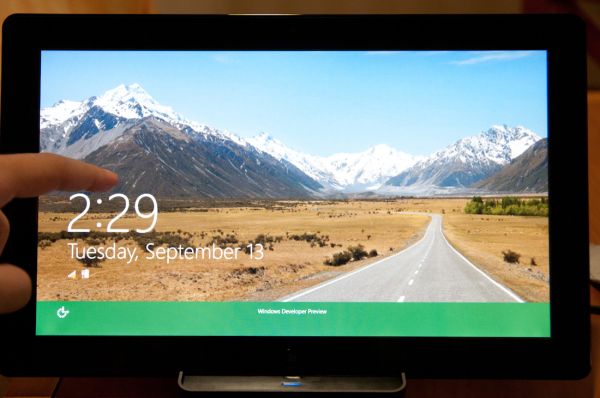
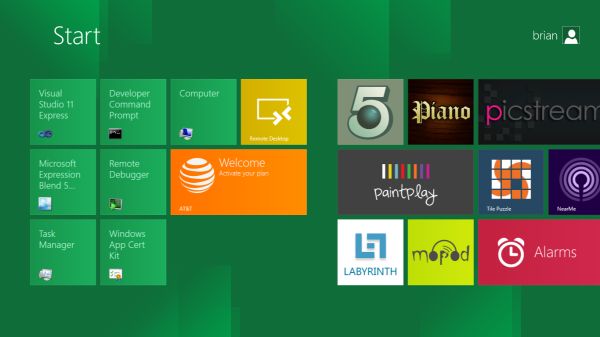
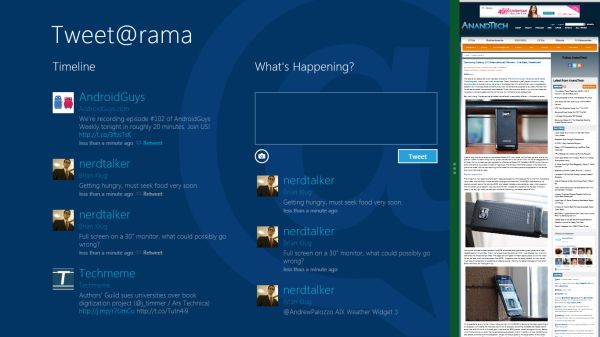
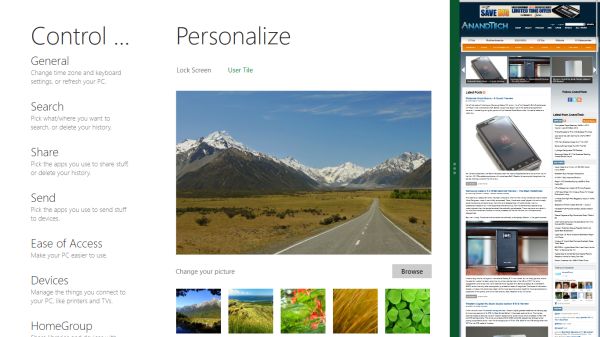

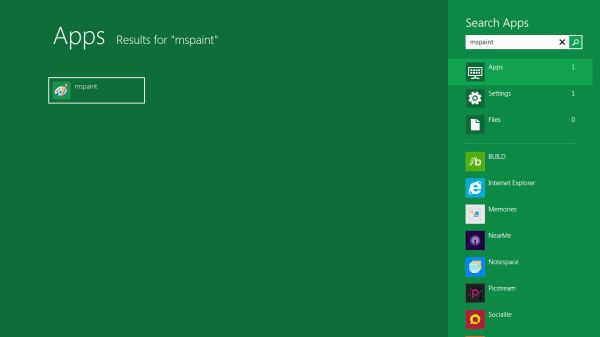
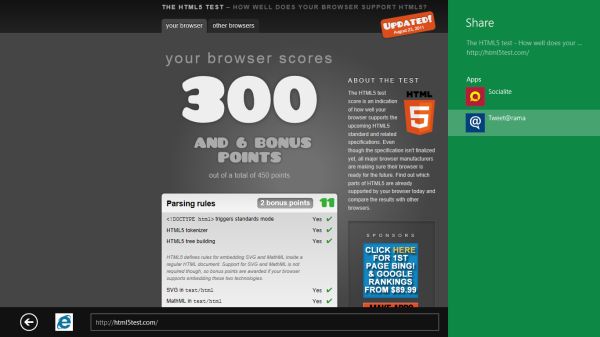
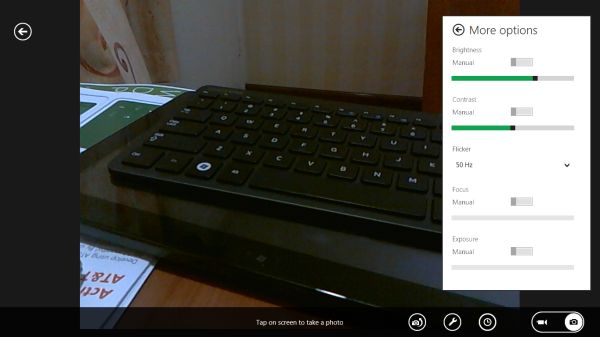
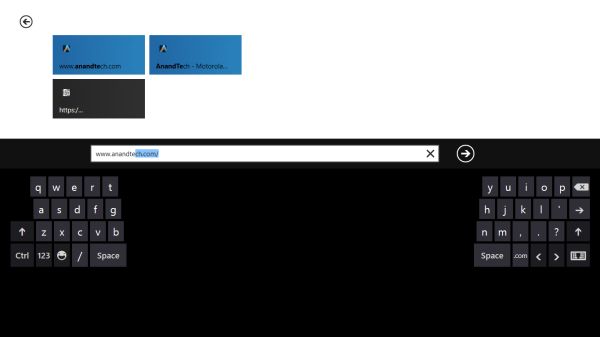








235 Comments
View All Comments
yankeeDDL - Wednesday, September 14, 2011 - link
I perfectly agree.Like with the security features of Vista, and with the Ribbon in Office, MS choose their way and are moving forward, thinking that they know what's best for you, despite having been proved wrong times and times again.
From their dominant position, they can still afford it.
Now they're pushing for the Metro UI, something interesting, but hardly revolutioning, like IOS and Android have been, an UI that will disappear from Samsung in 2012, because of its abysmal adoption.
PCs is the last stronghold of Windows: it disappeared from TVs, cars, mobiles: maybe it's about time they follow suit.
mlambert890 - Thursday, September 15, 2011 - link
Your own arguments prove you are completely wrong except possibly in your own mind.The security features of Vista evolved into the security features of W7 and are the same security features in OSX and Linux. On an extreme niche of curmudgeons that fancy themselves "super power users" bitch about dual privelege levels and access control gates within the OS.
Same with the ribbon. I was on the front lines of the most prepostrous bitching and moaning and DOOM calling over the ribbon. Today it is universally regarded as a good change or at the very least a neutral one.
One thing for sure thoug is that even folks who self describe as "technophiles" and truly believe they are cutting edge will act like 90 year olds whose drug store has moved as soon as *anything* changes. Sad really.
robinthakur - Wednesday, September 14, 2011 - link
I agree, but that isn't when you would be using Metro is it? It's for touch devices, although I don't understand how they are going to get it to work with legacy apps in the slightest. You need special versions of Excel, Word etc, build from the ground up for touch as Apple has done with Pages, Numbers, iMovie et al or it's just going to be a flashy acelerated interface which lacks full functionality and this guarantees that end users will hate it.This seems similar to how on an HTPC, to play a Blu-ray, you need to launch a 3rd party player which has a different look and feel and you need to break out the keyboard to control it. Awful, and so counter intuitive to users.
On the other hand, the fact that MS is involving developers at this stage, hopefully means that it's own first party products like Office/SharePoint etc. will work properly with it. They are doing alot right with Win 8, but seems like they are constantly playing catchup to Apple these days.
realmike15 - Sunday, September 18, 2011 - link
I think you're over simplifying the issue. Computing for toddlers? Last I checked toddlers aren't checking their stocks, the weather, rss feeds, and news. The simplified UI design is a good starting point, it makes navigating the computer interface easier those who find previous Windows releases daunting. Most old school techies aren't going to embrace this, but that's not because of poor design... it's because they're stuck in their ways. The old desktop system is clunky and archaic for everyday browsing. By no means is this a replacement for gaming, or other industries that require the tried and true keyboard/mouse setup. But that's why there's still a standard desktop.This IS a step in the right direction though, I have any delusions about this implementation being perfect. It will probably take many more versions of Windows to get this transition right, but it's a starting point. A starting point that your mother, grandmother, and all your non-tech savy friends will appreciate.
Belard - Tuesday, September 13, 2011 - link
Wait till it comes out on beta...Its still rough. I'll admit, I don't think of METRO much for a desktop and mouse... Why would I want to scroll through pages to get to some APPS when I can click on it from my task bar? But there is most likely something like that anyways. So think of Metro's arrangement switched around a bit to the side - which makes better use of todays STUPID 16:9 screens.
Look at Mac and Amiga - their "MENU" is at the top - MS has been at the bottom since Win95. Now its being shoved to the side
I bet MS has been studying user behavior quite a bit. And much of my work space is on the left side of the screen... tools on the right.
This is also perhaps the ONLY way MS has a chance to take on Apple's iOS and that MAKES perfect sense. It can improve future versions of MS-OS...
Windows7 tablets suck. WP7 is not made for tablets and is struggling to get market share. An MS-Tablet today will most likely go down in flames like WebOS, RIM and whatever... Android is not doing well against iPads.
But... MS commands about 90% of the world market in PCs. (about 75% in the USA in new sales). So... imagine the new Win8 desktops that come out, people have to get, there won't be Vista or Win7 to fall back on... ALL Metro apps are going to work on ARM based CPUs. (intel cannot be thrilled on this) This means those apps are going to be smaller than normal Win32 bloatware.
Now out comes the Win8 tablets and phones... in both types.
Win8 = tablet... high end, can run desktop software... faster CPUs $$$
Win8Mobile = Phones and tablets, they won't run legacy software (current game we see on desktops, Office 2010, etc) - but they'll RUN any Metro application and game.
Microsoft ends up creating the eco-system that can go against Apple... this is something RIM or Android cannot DO. They don't own the desktop business.
This is a brilliant move from MS, mark my words.
In the end 2012, I bet iPads will still own at least 70% of the tablet business.
By 2014, MS could flip it having 50~60% of the sales.
The iPad will always be called iPads... and MS-Tablets will always be called, Tablet like Android and Blackberry. They will always be the SODA to Apple's Coke. What matters for the next year or so before Win8 launch is how much more Apple can sell iPads. They'll be launching a new iPad 4 just after Win8 hits the market. If Apple can sell 50+ million units a year - they'll do well against Win8 up to a point.
Hopefully, MS will only have 3 versions PERIOD of Win8, all 64bit.
Win8 starter/ARM
Win8 Home
Win8 Pro (with Ultimate features built in)
If it goes well... then by the time Win10 comes out (7 years from now), the Win32 API an gone as well as any legacy 16bit, 32bit code...
We'll check in then... :)
Gimfred - Tuesday, September 13, 2011 - link
The problem with (not that it shouldn't be looked at) looking at user behaviour is it is studying how users work around the current limitations of a UI rather than the task that is intended to be achieved. Unfortunately Microsoft seems to have this idea that using a computer is the task.For tablets, they should implement and refine OneNote. That is awesome software.
robinthakur - Wednesday, September 14, 2011 - link
No, you're looking at it wrong. MS is currently in a dominant position worldwide with Windows, especially in business, but things are changing. Apple phones are being issued in many companies an many executives, because they use iPad's and Macbook Airs are introducing them into business, and saying "Just make it work" I have seen this innumerable times in the past 3 years. For my last firm, an investment bank, the whole website had to be scrapped and redesigned close to launch because a senior exec noticed that it didn't render properly on her iPad.At the same time, the desktop business is under pressure like never before. Companies are scaling back the amount of power and flexibility that they are giving to individual employees. We use thin clients extensively running MS Terminal Serverfor virtually all employees. Those that want them are issued with company iPads instead and seem very happy with them, running a propriatery app which we designed here and the standard iPad functionality.
All we used to hear were constant complaints about Windows from staff, and just because us, as techies, can divine how to use it doesn't mean that regular people will. They seem to prefer the iPads because they instinctively know how to use it. Training needs have gone from all encompassing to pretty non-existant apart from SharePoint (which I love) so cutting down functionality is actually not a bad idea if it's functionality which people rarely use.
About the only reason to own a powerful desktop these days is if you are a power user/developer, you are a techie and like to play/brag or you play games (the latter being a nearly non-existant demographic these days) with the rest buying laptops/iPads, and I can only see that becoming more pronounced in the future.
piiman - Wednesday, September 14, 2011 - link
The fact that you think the the iPad is taking over business is simply laughable.If some exec is forcing it on a company because they personally use it then it should be grounds for firing them.
mlambert890 - Thursday, September 15, 2011 - link
Whats laughable is that you dont realize he is correct yet feel so confident making absolute statements like this.Your personal bias and/or emotions dont change the fact that what he is saying is absolutely correct.
I dont care one way or the other what the client solution of choice is for my customers, but I can tell you now the shift is *massive* towards iPads in particular, to a lesser extent phones, and even Android tablets.
nitenichiryu1 - Tuesday, September 13, 2011 - link
At 8:18, he says that Windows 8 will be both METRO and TRADITIONAL desktop. Yay =D